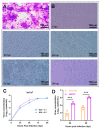Characterization of Human Immortalized Keratinocyte Cells Infected by Monkeypox Virus
- PMID: 39205180
- PMCID: PMC11359611
- DOI: 10.3390/v16081206
Characterization of Human Immortalized Keratinocyte Cells Infected by Monkeypox Virus
Abstract
Monkeypox virus (MPXV) can induce systemic skin lesions after infection. This research focused on studying MPXV proliferation and the response of keratinocytes. Using transmission electron microscopy (TEM), we visualized different stages of MPXV development in human immortalized keratinocytes (HaCaT). We identified exocytosis of enveloped viruses as the exit mechanism for MPXV in HaCaT cells. Infected keratinocytes showed submicroscopic changes, such as the formation of vesicle-like structures through the recombination of rough endoplasmic reticulum membranes and alterations in mitochondrial morphology. Transcriptome analysis revealed the suppressed genes related to interferon pathway activation and the reduced expression of antimicrobial peptides and chemokines, which may facilitate viral immune evasion. In addition, pathway enrichment analysis highlighted systemic lupus erythematosus pathway activation and the inhibition of the Toll-like receptor signaling and retinol metabolism pathways, providing insights into the mechanisms underlying MPXV-induced skin lesions. This study advances our understanding of MPXV's interaction with keratinocytes and the complex mechanisms leading to skin lesions.
Keywords: HaCaT; RNA-seq; TEM; characterization; monkeypox virus.
Conflict of interest statement
The authors declare no conflicts of interest.
Figures






References
Publication types
MeSH terms
Associated data
- Actions
Grants and funding
LinkOut - more resources
Full Text Sources

